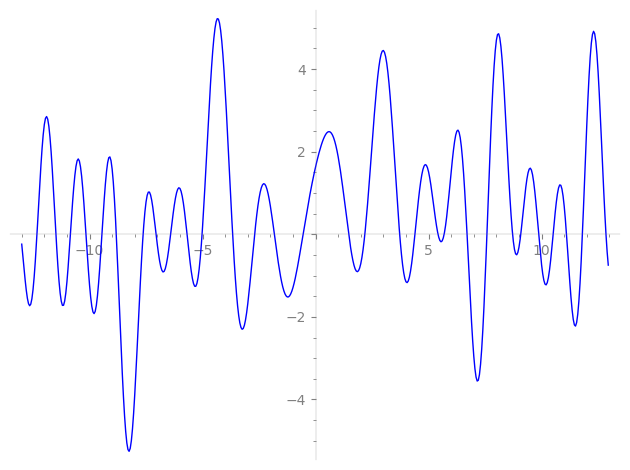| L(s) = 1 | + (−0.646 − 1.12i)3-s + (2.42 + 1.39i)5-s + (0.663 − 1.14i)9-s + (−0.894 + 0.516i)11-s + (1.79 − 3.12i)13-s − 3.62i·15-s + (−3.47 − 6.02i)17-s + (2.19 + 1.26i)19-s + (1.91 − 3.31i)23-s + (1.41 + 2.45i)25-s − 5.59·27-s − 5.10·29-s + (−3.28 + 1.89i)31-s + (1.15 + 0.668i)33-s + (−5.37 − 3.10i)37-s + ⋯ |
| L(s) = 1 | + (−0.373 − 0.646i)3-s + (1.08 + 0.625i)5-s + (0.221 − 0.382i)9-s + (−0.269 + 0.155i)11-s + (0.498 − 0.866i)13-s − 0.934i·15-s + (−0.843 − 1.46i)17-s + (0.504 + 0.291i)19-s + (0.399 − 0.691i)23-s + (0.283 + 0.490i)25-s − 1.07·27-s − 0.947·29-s + (−0.589 + 0.340i)31-s + (0.201 + 0.116i)33-s + (−0.883 − 0.510i)37-s + ⋯ |
Λ(s)=(=(2548s/2ΓC(s)L(s)(−0.265+0.964i)Λ(2−s)
Λ(s)=(=(2548s/2ΓC(s+1/2)L(s)(−0.265+0.964i)Λ(1−s)
| Degree: |
2 |
| Conductor: |
2548
= 22⋅72⋅13
|
| Sign: |
−0.265+0.964i
|
| Analytic conductor: |
20.3458 |
| Root analytic conductor: |
4.51064 |
| Motivic weight: |
1 |
| Rational: |
no |
| Arithmetic: |
yes |
| Character: |
χ2548(961,⋅)
|
| Primitive: |
yes
|
| Self-dual: |
no
|
| Analytic rank: |
0
|
| Selberg data: |
(2, 2548, ( :1/2), −0.265+0.964i)
|
Particular Values
| L(1) |
≈ |
1.631345942 |
| L(21) |
≈ |
1.631345942 |
| L(23) |
|
not available |
| L(1) |
|
not available |
L(s)=p∏Fp(p−s)−1 | p | Fp(T) |
|---|
| bad | 2 | 1 |
| 7 | 1 |
| 13 | 1+(−1.79+3.12i)T |
| good | 3 | 1+(0.646+1.12i)T+(−1.5+2.59i)T2 |
| 5 | 1+(−2.42−1.39i)T+(2.5+4.33i)T2 |
| 11 | 1+(0.894−0.516i)T+(5.5−9.52i)T2 |
| 17 | 1+(3.47+6.02i)T+(−8.5+14.7i)T2 |
| 19 | 1+(−2.19−1.26i)T+(9.5+16.4i)T2 |
| 23 | 1+(−1.91+3.31i)T+(−11.5−19.9i)T2 |
| 29 | 1+5.10T+29T2 |
| 31 | 1+(3.28−1.89i)T+(15.5−26.8i)T2 |
| 37 | 1+(5.37+3.10i)T+(18.5+32.0i)T2 |
| 41 | 1−0.990iT−41T2 |
| 43 | 1−0.560T+43T2 |
| 47 | 1+(−6.22−3.59i)T+(23.5+40.7i)T2 |
| 53 | 1+(0.589+1.02i)T+(−26.5+45.8i)T2 |
| 59 | 1+(−10.3+5.96i)T+(29.5−51.0i)T2 |
| 61 | 1+(−6.92+11.9i)T+(−30.5−52.8i)T2 |
| 67 | 1+(11.9−6.89i)T+(33.5−58.0i)T2 |
| 71 | 1+3.80iT−71T2 |
| 73 | 1+(−2.76+1.59i)T+(36.5−63.2i)T2 |
| 79 | 1+(3.66−6.35i)T+(−39.5−68.4i)T2 |
| 83 | 1+16.6iT−83T2 |
| 89 | 1+(−10.3−5.94i)T+(44.5+77.0i)T2 |
| 97 | 1+8.60iT−97T2 |
| show more | |
| show less | |
L(s)=p∏ j=1∏2(1−αj,pp−s)−1
Imaginary part of the first few zeros on the critical line
−8.817465223685678971461965385490, −7.62945241813893774154822081920, −7.05598536639200086786370392464, −6.41268858195890665448981243316, −5.68566768357019661662208232006, −5.02142859601844271036803068104, −3.66859753443529566543017811438, −2.69515707420621254601574439080, −1.82227211736056268478490712343, −0.55285574257926996945556979252,
1.46681555373175937534649874508, 2.17956309832178880107563434532, 3.72156410900588993217823825890, 4.39591763131123108437421313211, 5.41849699199180869750751303693, 5.68782123378028480119407910179, 6.70251679431864288281456880162, 7.58122720920630288941467461571, 8.717432002620776791420848986587, 9.078285914610475076700582186403

